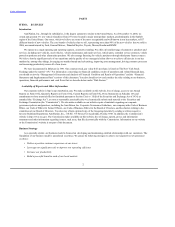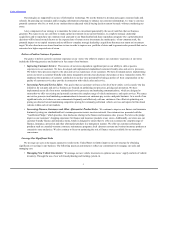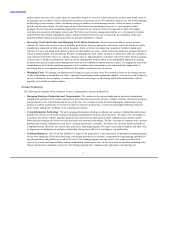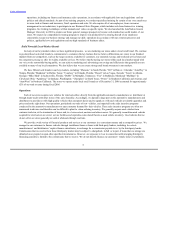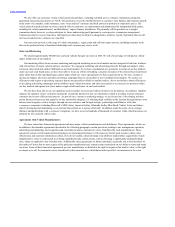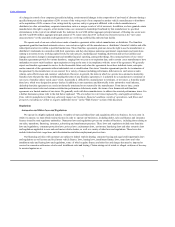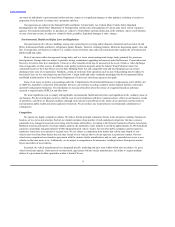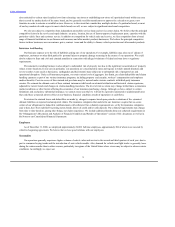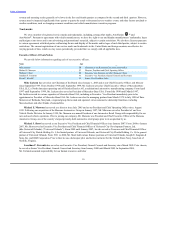AutoNation 2006 Annual Report Download - page 13
Download and view the complete annual report
Please find page 13 of the 2006 AutoNation annual report below. You can navigate through the pages in the report by either clicking on the pages listed below, or by using the keyword search tool below to find specific information within the annual report.
Table of Contents
captive finance subsidiary, which may cause us to finance our new vehicle inventory, and arrange financing for our customers, with
alternate finance sources on less favorable terms, and (iv) consumer demand for their products could be materially adversely affected.
These events may result in a partial or complete write-down of our goodwill, intangible franchise rights with respect to any terminated
franchises, and/or receivables due from such manufacturers and adversely impact our results of operations. In addition, vehicle
manufacturers may be adversely impacted by economic downturns or recessions, significant declines in the sales of their new vehicles,
increases in interest rates, declines in their credit ratings, labor strikes or similar disruptions (including within their major suppliers),
supply shortages or rising raw material costs, rising employee benefit costs, adverse publicity that may reduce consumer demand for
their products (including due to bankruptcy), product defects, vehicle recall campaigns, litigation, poor product mix or unappealing
vehicle design, changes in governmental laws and regulations, including a significant increase in the U.S. mandated corporate average
fuel economy standards that could materially adversely impact our sales and profitability, or other adverse events. These and other risks
could materially adversely affect any manufacturer and impact its ability to profitably design, market, produce or distribute new
vehicles, which in turn could materially adversely affect our ability to obtain or finance our new vehicle inventories, our ability to take
advantage of manufacturer financial assistance programs, our ability to collect in full or on a timely basis our manufacturer warranty
and other receivables, and/or our ability to obtain other goods and services provided by the impacted manufacturer. Our business, results
of operations, financial condition, shareholders’ equity, cash flows and prospects could be materially adversely affected as a result of
any event that has a material adverse effect on the vehicle manufacturers or distributors who are our primary franchisors.
The automotive retailing industry is sensitive to changing economic conditions and various other factors. Our business and
results of operations are substantially dependent on new vehicle sales levels in the United States and in our particular
geographic markets and the level of gross profit margins that we can achieve on our sales of new vehicles, all of which are very
difficult to predict.
We believe that many factors affect sales of new vehicles and retailers’ gross profit margins in the United States and in our
particular geographic markets, including the economy, inflation, recession or economic slowdown, consumer confidence, housing
markets, the level of manufacturers’ production capacity, manufacturer incentives (and consumers’ reaction to such offers), intense
industry competition, interest rates, the prospects of war, other international conflicts or terrorist attacks, severe weather conditions, the
level of personal discretionary spending, product quality, affordability and innovation, fuel prices, credit availability, unemployment
rates, the number of consumers whose vehicle leases are expiring, and the length of consumer loans on existing vehicles. Increases in
interest rates could significantly impact industry new vehicle sales and vehicle affordability, including due to the direct relationship
between higher rates and higher monthly loan payments, a critical factor for many vehicle buyers, and the impact higher rates can have
on customers’ borrowing capacity and disposable income. Sales of certain new vehicles, particularly larger trucks and sports utility
vehicles that historically have provided us with higher gross margins, also could be impacted adversely by significant increases in fuel
prices. Additionally, in 2006, the housing market experienced a significant decline, particularly in California and Florida. A continued
decline in the housing market, particularly in the geographic regions in which we operate, could materially adversely impact our sales.
Our new vehicle sales may differ from industry sales, including due to particular economic conditions and other factors in the
geographic markets in which we operate. A significant decrease in new vehicle sales levels in the United States (or in our particular
geographic markets) in the future, or a decrease in new vehicle gross profit margins, could cause our actual earnings results to differ
materially from our prior results and projected trends. Economic conditions and the other factors described above also may materially
adversely impact our sales of used vehicles, finance and vehicle protection products, vehicle service and parts and repair services.
Our new vehicle sales are impacted by the consumer incentive and marketing programs of vehicle manufacturers.
Most vehicle manufacturers from time to time have established various incentive and marketing programs designed to spur
consumer demand for their vehicles. In addition, certain manufacturers offer extended product warranties or free service programs to
consumers. From time to time, manufacturers modify and discontinue these
12


